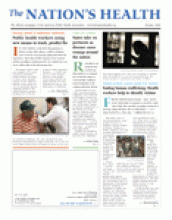Reports of pertussis have reached startling numbers in communities around the nation in recent months, leading to renewed attention to the common infectious disease.
Several states are currently reporting pertussis outbreaks, from California to Michigan to South Carolina. California’s caseload has caught the most attention, as the state is home to epidemic proportions of the disease. As of late August, California health officials reported more than 3,300 confirmed, probable and suspected pertussis cases — a seven-fold increase from the previous year — as well as at least eight deaths.
Despite the resurgence, public health workers caution that such outbreaks are not unexpected and should serve as important immunization reminders.
Reported cases of the highly communicable disease have been on the rise since the 1980s. Pertussis outbreaks usually occur in three- to five-year cycles, with the last pertussis peak occurring in 2005, with more than 25,600 cases, according to the Centers for Disease Control and Prevention. In 2009, about 16,900 cases were reported to CDC. For 2010, about 10,400 cases had been reported as of Aug. 28.
Controlling pertussis, commonly known as whooping cough, comes with a number of common public health challenges, such as gathering representative case data and encouraging people to keep their immunizations up to date. However, new and emerging tools, such as the 2005 arrival of a new vaccine that immunizes adolescents and adults against pertussis, could make a dent in the disease’s natural cycle. While pertussis and its prevention is complex, speculations that current outbreaks may be due to vaccine refusal do not hold up, said CDC spokesman Jeff Dimond.
“The numbers don’t support that argument,” Dimond said. “There’s no cause and effect relationship there.”
Instead, waning immunity may be part of the problem. To confront the disease, CDC and health departments nationwide are urging residents to get immunized, especially adults who come in contact with infants and young children. Infants are routinely vaccinated against pertussis, with children ideally receiving five doses of the diphtheria, tetanus and pertussis vaccine, or DTaP vaccine, by age 6. Another similar vaccine, know as Tdap, is recommended for people ages 11 through 64. Unlike some vaccines, the pertussis vaccine’s protection eventually wears off, as does any immunity gained from contracting the disease.
In Michigan, where public health officials have been monitoring a general increase in pertussis over the past two decades, the majority of recent cases are among residents 10 years of age and older, according to Joel Blostein, MPH, a vaccine-preventable disease epidemiologist with the Michigan Department of Community Health.
“Part of the cycle is the number of susceptible people in the population that builds up over time,” Blostein said. “Eventually, there’s enough susceptible people that the bug will much more readily transmit and gain a foothold, and we’ll get an explosive number of cases.”
Pertussis cases in Michigan began an upward tick in late 2008, Blostein said, with 902 cases in 2009 and 610 cases as of mid-August. He cautioned that case numbers over the years may not be completely representative, as better diagnostics and efforts to look for the disease in nontraditional age groups are likely factors in changing case numbers. The current outbreak is being reported in “all corners of the state…across all strata of socioeconomic status,” Blostein noted.
In response, Michigan health workers are working to raise awareness among clinicians that pertussis is more than a childhood disease and stressing the importance of creating a cocoon of protection around children via the immunization of adults, among whom pertussis can seem like little more than a cold. Similar education efforts are at the forefront of response efforts in Onondaga County in upstate New York, where this year’s pertussis cases had reached 100 by late August, compared to 12 cases in 2009.
The majority of cases in Onondaga County are among children ages 9 to 12 years old, many of whom were vaccinated against pertussis but have yet to get a booster shot, according to Cynthia Morrow, MD, MPH, the county’s commissioner of health.
“While we’re still seeing pertussis at high levels, we’re not seeing it in really young infants…which may mean that since we’re protecting adults, we may be protecting infants, but it’s too early to really know,” Morrow told The Nation’s Health.
Morrow said day-to-day efforts to contain the outbreak focus on working with health care providers, preventing transmission via contact investigations and working with laboratories to ensure appropriate testing. Many factors contribute to the reporting of pertussis cases, but Morrow said “there is no doubt in my mind that we are seeing a true increase.”
One challenge with pertussis reporting lies with its diagnosis. Traditional culture tests are still the standard for pertussis, but getting results can take up to a week. Fortunately, more public health labs are now using real-time polymerase chain reaction testing, more simply known as real-time PCR, according to Kathleen Tatti, PhD, a biologist with CDC’s Pertussis and Diphtheria Laboratory. The real-time test, which labs began using in the past several years, can get results in a few hours, she said. But the lack of standardized pertussis testing across public health labs can make it difficult to know the true disease burden, she noted.
“Standardization would definitely help us interpret the results,” said Tatti, who reported that CDC has developed two new diagnostic tests that are even more specific in detecting pertussis.
In South Carolina, James Gibson, MD, MPH, state epidemiologist and director of the state health department’s Bureau of Disease Control, said reported pertussis cases in the state are “far from representative,” with many cases among older residents likely going undetected.
“We know that there are several cases among teens and older people for every one (case of pertussis) identified,” said Gibson, who is an APHA member.
Pertussis is on the rise this year in South Carolina, with 168 cases reported as of June 30. Gibson noted that with cuts in state and federal discretionary funds, it is getting harder to provide vaccines to the state’s underinsured children, even though vaccines are highly cost-effective when compared to treating disease — “it’s a no-brainer from a public health point of view,” he said. Like his public health colleagues nationwide, Gibson said educating health care providers is key.
“Studies show that the most effective way to influence a person to get vaccinated is to make sure their doctor recommends it to them,” he told The Nation’s Health.
For more information on the pertussis outbreak, visit www.cdc.gov/vaccines/vpd-vac/pertussis.
- Copyright The Nation’s Health, American Public Health Association












